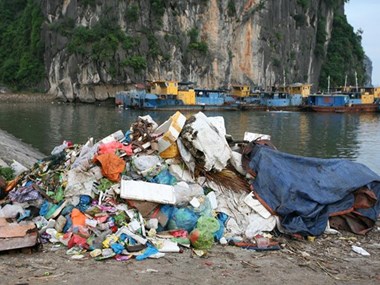Vietnam is one of five leading countries responsible for the 13 million tons of plastic waste discharged into the ocean every year, according to some international organizations. But it still has not conducted research on plastic waste pollution at the national level.

“What we are concerned about is the origin and types of waste into the ocean, the ‘hot spots’ of plastic pollution. We need to define the purposes and measures to prevent waste, to identify the possible impacts on biodiversity, human health, food security, marine safety, and outline plans on tourism and entertainment industry development,” said Nguyen Thu Trang, co-founder of GreenHub.
To build a method which can be commonly used for all coastal localities, IUCN Vietnam and GreenHub organized a fact-finding and supervision trip to MPAs and national parks throughout the country.
|
To build a method which can be commonly used for all coastal localities, IUCN Vietnam and GreenHub organized a fact-finding and supervision trip to MPAs and national parks throughout the country. |
Bui Thi Thu Hien from IUCN said they wanted to provide more data about ocean waste and plastic pollution in MPAs and national parks in Vietnam.
Asked why MPAs and national parks were the destinations, Hien said even places which are put under strict protection cannot avoid pollution from plastic waste.
To date, the supervision has finished in four MPAs and national parks Bai Tu Long, Cat Ba, Con Dao and Phu Quoc.
According to Trang from GreenHub, a member of the group of supervisors, 91-97 percent of waste found was plastic, mostly foam, floats and plastic bags.
In Phu Quoc MPA, plastic waste accounted for 94 percent of total waste collected. Foam from floating works, fishery activities and food containers accounted for the highest proportion, 32-37 percent.
The same situation was seen in Cat Ba National Park.
Meanwhile, in Con Dao, plastic nets and bottles accounted for the highest proportion.
“In Cat Ba, we found plastic bags covering coral reefs, which could hinder the development of corals, and affect Cat Ba langurs,” Trang said.
The trip found that plastic waste is a burning issue at MPAs and national parks. The investigation on plastic waste should be listed as a regular activity in a long-term supervision program to serve biodiversity conservation.
Hien said that it is necessary to implement this four days a year, in two seasons. He said the cost of the program is not high, and it can bring great benefits.
Thien Nhien

Vietnam's tourism sector fights against plastic waste
The Vietnam Tourism Association and its chapters in the northern mountainous provinces of Phu Tho, Hoa Binh and Son La provinces are scheduled to launch an anti-plastic-waste action programme from July 15 to 17.

Vietnam's islands to eliminate plastic waste
The Cham Islands’ Marine Protected Area management board, in co-operation with the International Union for Conservation of Nature, has launched a new garbage sorting programme as part of efforts to reduce plastic waste in Vietnam.
 The recent tour to assess the amount of plastic waste, organized by IUCN and GreenHub, included four marine protected areas (MPAs) and national parks. The picture about plastic waste in coastal areas was clear.
The recent tour to assess the amount of plastic waste, organized by IUCN and GreenHub, included four marine protected areas (MPAs) and national parks. The picture about plastic waste in coastal areas was clear.